Plants with a Christmas theme.
There are many plants we associate with the Christmas season... mistletoe, holly, fir and pine trees. In Australia each state seems to have its particular Christmas plant. Here's a rundown on the history and meaning of some of the plants that have become part of the Christmas custom.
The holly and the ivy.
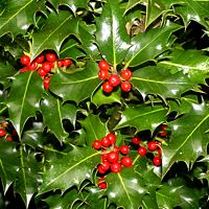
Holly, Ivy and other greenery such as Mistletoe were originally used in pre-Christian times to help celebrate the Winter Solstice Festival and ward off evil spirits and to celebrate new growth.
When Christianity came into Western Europe, some people wanted to keep the greenery, give it Christian meanings, but also ban the use of it to decorate homes. The UK and Germany were the main countries to keep the use of the greenery as decorations. Here are the Christian meanings:
HOLLY
The prickly leaves represent the crown of thorns that Jesus wore when he was crucified. The berries are the drops of blood that were shed by Jesus because of the thorns. In Scandinavia it is known as the Christ Thorn.
In pagan times, Holly was thought to be a male plant and Ivy a female plant. An old tradition from the Midlands of England says that whatever one was brought into the house first over winter, tells you whether the man or woman of the house would rule that year! But it was unlucky to bring either into a house before Christmas Eve.
When Christianity came into Western Europe, some people wanted to keep the greenery, give it Christian meanings, but also ban the use of it to decorate homes. The UK and Germany were the main countries to keep the use of the greenery as decorations. Here are the Christian meanings:
HOLLY
The prickly leaves represent the crown of thorns that Jesus wore when he was crucified. The berries are the drops of blood that were shed by Jesus because of the thorns. In Scandinavia it is known as the Christ Thorn.
In pagan times, Holly was thought to be a male plant and Ivy a female plant. An old tradition from the Midlands of England says that whatever one was brought into the house first over winter, tells you whether the man or woman of the house would rule that year! But it was unlucky to bring either into a house before Christmas Eve.
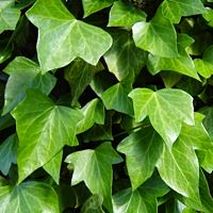
IVY
Ivy has to cling to something to support itself as it grows. This reminds us that we need to cling to God for support in our lives.
In Germany, it is traditional that Ivy is only used outside and a piece tied to the outside of a Church was supposed to protect it from lightning!
Ivy has to cling to something to support itself as it grows. This reminds us that we need to cling to God for support in our lives.
In Germany, it is traditional that Ivy is only used outside and a piece tied to the outside of a Church was supposed to protect it from lightning!
Poinsettia
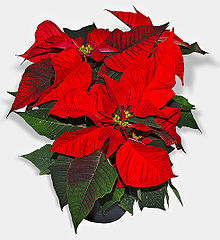
The plant's association with Christmas began in 16th-century Mexico, where legend tells of a girl, commonly called Pepita or Maria, who was too poor to provide a gift for the celebration of Jesus' birthday and was inspired by an angel to gather weeds from the roadside and place them in front of the church altar. Crimson blossoms sprouted from the weeds and became beautiful poinsettias. From the 17th century, Franciscan friars in Mexico included the plants in their Christmas celebrations. The star-shaped leaf pattern is said to symbolize the Star of Bethlehem, and the red color represents the blood sacrifice through the crucifixion of Jesus. Poinsettias are popular Christmas decorations in homes, churches, offices, and elsewhere across North America. They are available in large numbers from grocery, drug, and hardware stores. In the United States, December 12 is National Poinsettia Day.
Mistletoe
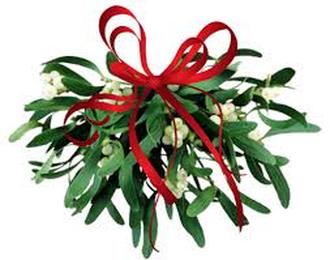
Mistletoe was held sacred by the Norse, the Celtic Druids and the North American Indians. The Druid priests would cut mistletoe from an oak tree with a golden sickle. The branches had to be caught before they touched the ground. They then divided the branches into many sprigs and distributed them to the people, who hung them over doorways as protection against thunder, lightning and other evils. In fact, in the Celtic language mistletoe means "all-heal."
Mistletoe is a symbol for peace and joy. The idea originated in the ancient times of the Druids: whenever enemies met under the mistletoe in the forest, they had to lay down their arms and observe a truce until the next day. From this comes the custom of hanging a ball of mistletoe from the ceiling and exchanging kisses under it as a sign of friendship and goodwill.
Later, the eighteenth-century English credited mistletoe not with miraculous healing powers, but with a certain magical appeal called a kissing ball. At Christmas time a young lady standing under a ball of mistletoe, brightly trimmed with evergreens, ribbons, and ornaments, cannot refuse to be kissed. Such a kiss could mean deep romance or lasting friendship and goodwill. If the girl remained unkissed, she cannot expect not to marry the following year. Whether we believe it or not, it always makes for fun and frolic at Christmas celebrations.
Mistletoe is a symbol for peace and joy. The idea originated in the ancient times of the Druids: whenever enemies met under the mistletoe in the forest, they had to lay down their arms and observe a truce until the next day. From this comes the custom of hanging a ball of mistletoe from the ceiling and exchanging kisses under it as a sign of friendship and goodwill.
Later, the eighteenth-century English credited mistletoe not with miraculous healing powers, but with a certain magical appeal called a kissing ball. At Christmas time a young lady standing under a ball of mistletoe, brightly trimmed with evergreens, ribbons, and ornaments, cannot refuse to be kissed. Such a kiss could mean deep romance or lasting friendship and goodwill. If the girl remained unkissed, she cannot expect not to marry the following year. Whether we believe it or not, it always makes for fun and frolic at Christmas celebrations.
Christmas cactus
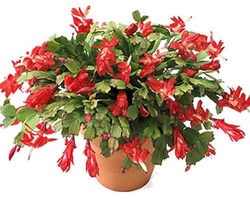
The Christmas cactus is a cultivar of the genus Schlumbergera and is popular for its bright pink and red flowers that appear during the Christmas season. It is native to the coastal mountains of south-east Brazil where it is found growing on trees and rocks. Many members of the cactus family are under threat in the wild and conservation of these plants is an important and urgent task. BGCI has been conducting a survey to find out which cactus and succulent species are conserved in the living collections of botanic gardens as an insurance against their extinction in the wild.
Cranberry
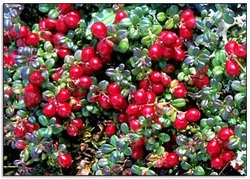
The cranberry (Vaccinium spp.) has been a festive favourite for hundreds of years, ever since Native Americans mashed up the fruit and mixed it with dried deer meat and fat to make pemmican (a concentrated mixture of fat and protein used as a nutritious food). In 1816, Dutch and German settlers in the New World planted the first ever "crane berry" crop (so-called for their blossom’s resemblance to the head and bill of a crane) on Cape Cod, using the fruit as a natural dye for rugs, blankets and clothing.
Australian Christmas plants
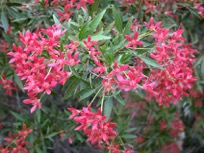
NSW Christmas Bush (Ceratopetalum gummiferum)
This good-looking evergreen native shrub has three-pointed leaves and creamy flowers in spring. After flowering the calyxes turn a rusty red for a stunning Christmas show. They glow brightly in the Eastern Australian bushland, and are easy to grow in the garden. ‘Albery’s Red’ is a popular cultivar. Cultivation: Christmas bush will grow in sun or semi-shade, although flowering is best if planted in full sun. Choose a well-drained spot with reliable moisture.
This good-looking evergreen native shrub has three-pointed leaves and creamy flowers in spring. After flowering the calyxes turn a rusty red for a stunning Christmas show. They glow brightly in the Eastern Australian bushland, and are easy to grow in the garden. ‘Albery’s Red’ is a popular cultivar. Cultivation: Christmas bush will grow in sun or semi-shade, although flowering is best if planted in full sun. Choose a well-drained spot with reliable moisture.

- Victorian Christmas Bush Prostanthera lasianthos Lamiaceae
- Variable shrub or small tree, from 2 m to 10 m high. Often has a compact habit when in shrub form. Leaves are lanceolate to ovate, to 10 cm. Flowers in terminal sprays, white, pink or mauve, occur in summer. Propagation: From cuttings. Cultivation: Probably the most adaptable species. Tolerates heavy shade or full sun. Fast growing. Useful as a screen plant. A cultivar with variegated leaves is known as P. lasianthos
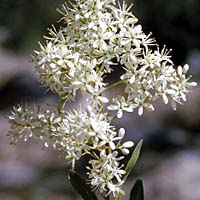
South Australian and Tasmanian Christmas Bush Bursaria spinosa Pittosporaceae
Erect, thorny shrub to 3 m and often taller. Dark green, obovate, shiny leaves to 2.5 cm. Masses of white flowers cover bush in late spring and summer, followed by attractive brown fruits. Distribution: all States except WA. Propagation: From cuttings or seed. Cultivation: A very hardy plant that will grow in almost any situation. Fruits are useful in floral arrangements. Subject to scale attack in some areas.
Erect, thorny shrub to 3 m and often taller. Dark green, obovate, shiny leaves to 2.5 cm. Masses of white flowers cover bush in late spring and summer, followed by attractive brown fruits. Distribution: all States except WA. Propagation: From cuttings or seed. Cultivation: A very hardy plant that will grow in almost any situation. Fruits are useful in floral arrangements. Subject to scale attack in some areas.
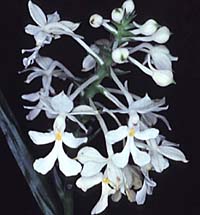
Queensland Christmas Orchid Calanthe triplicata Orchidaceae
(Syn. C. veratrifolia)
Evergreen terrestrial orchid. Soft, obovate leaves to 90 cm. Showy white flowers borne on erect spike to 150 cm in summer.
Propagation: From seed or by division.
Cultivation: Readily grown in heavily shaded, moist but not badly drained position in sheltered, warm garden. Excellent pot plant.
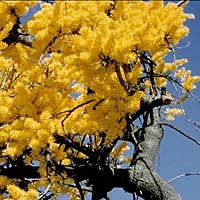
Western Australian Christmas Tree Nuytsia floribunda Loranthaceae
Parasitic tree to 10 m with variable foliage. Brilliant yellow flowers are profuse in summer. Propagation: From seed or root cuttings. Cultivation: Very difficult. Success has been achieved in Perth in raising this plant to flowering stage. Young plants are also growing in the eastern States. As the plant is partially reliant on a host plant for nutrition, grasses and strawberries have been used as companion plantings. Further work is required to fully understand the correct cultivation of this worthwhile species. Needs full sun and appears to be frost resistant.
Parasitic tree to 10 m with variable foliage. Brilliant yellow flowers are profuse in summer. Propagation: From seed or root cuttings. Cultivation: Very difficult. Success has been achieved in Perth in raising this plant to flowering stage. Young plants are also growing in the eastern States. As the plant is partially reliant on a host plant for nutrition, grasses and strawberries have been used as companion plantings. Further work is required to fully understand the correct cultivation of this worthwhile species. Needs full sun and appears to be frost resistant.
